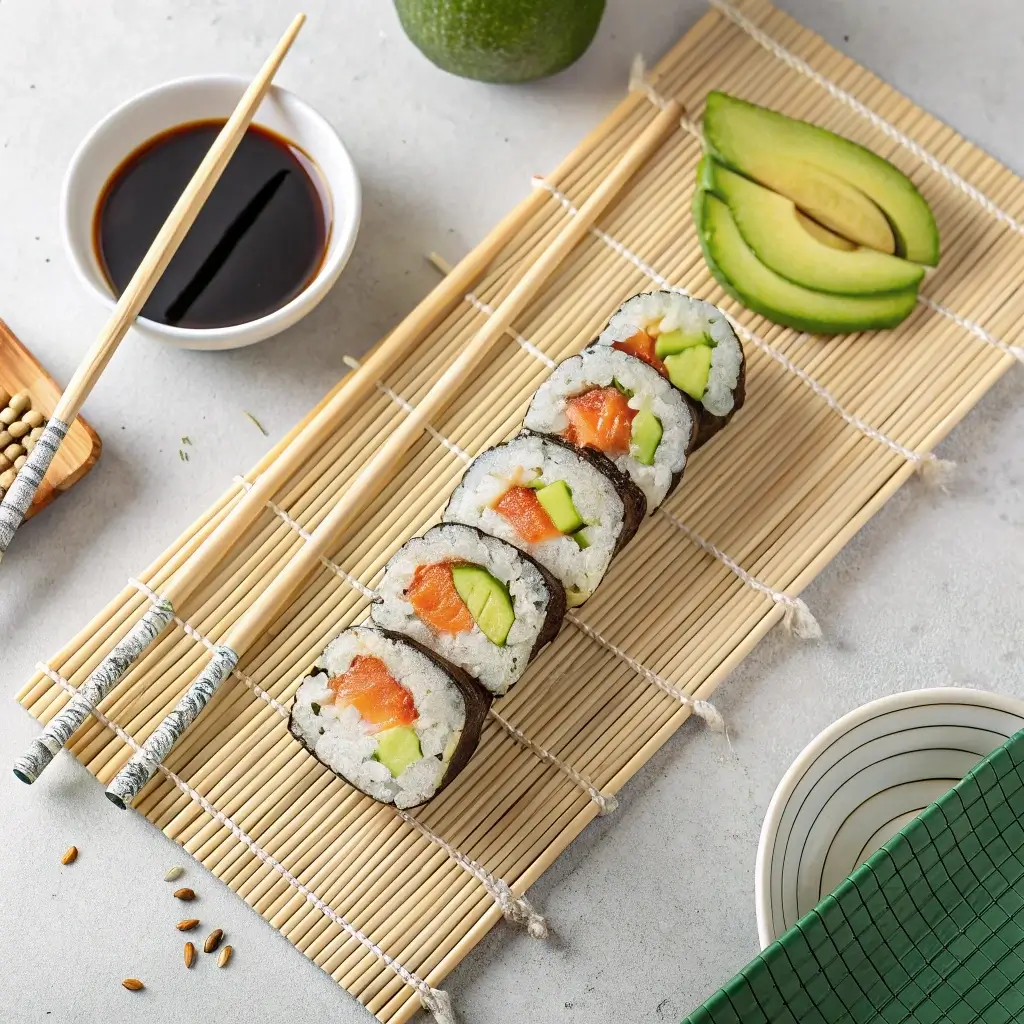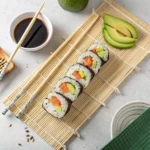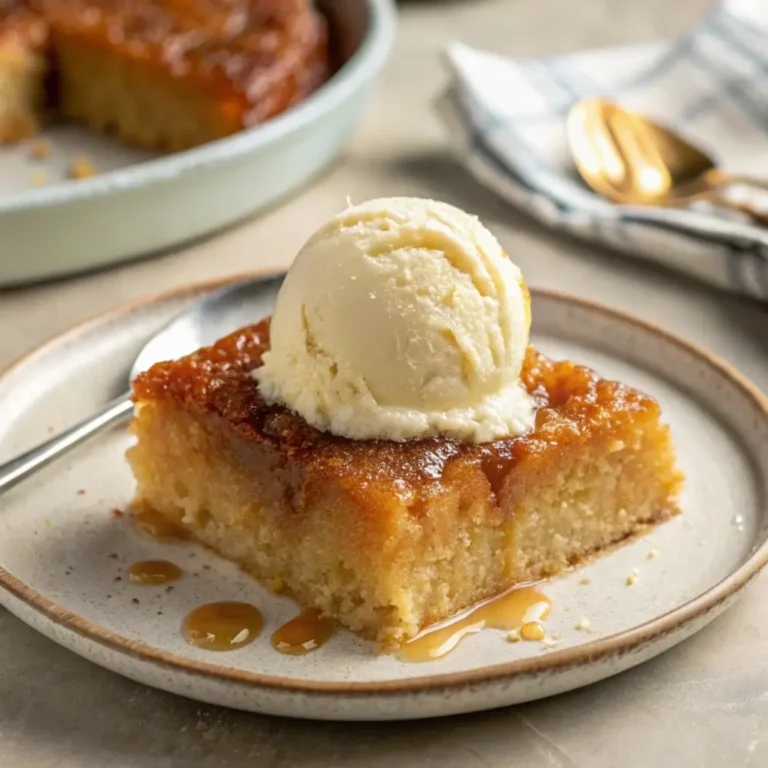If you’re a sushi lover looking to make smarter choices, the salmon avocado roll probably feels like a “safe” bet. It’s got lean fish, creamy avocado, and isn’t fried or smothered in sauce. But is it really as healthy as it sounds?
Let’s dig into the details. In this article, we’ll break down exactly what goes into a salmon avocado roll, what makes it a nutritious option (and what to watch out for), and how it stacks up against other sushi favorites. Whether you’re trying to lose weight, eat cleaner, or just stay informed, here’s the real answer to:
Is salmon avocado roll healthy?
👉 Check out our Salmon Avocado Roll Recipe for a quick, fresh version you can make at home.
What’s in a Salmon Avocado Roll?
The Basics
A traditional salmon avocado roll is made of:
- Sushi rice
- Nori (seaweed)
- Fresh salmon (raw or smoked)
- Ripe avocado
Sometimes you’ll see it topped with sesame seeds or served with soy sauce, wasabi, or pickled ginger.
A standard roll (6–8 pieces) contains:
| Nutrient | Approx. Amount |
|---|---|
| Calories | 300–350 |
| Protein | 13–15g |
| Fat | 12–14g |
| Carbs | 30–35g |
| Fiber | 3–4g |
Pretty balanced, right? The combo of protein, healthy fats, and carbs makes it more filling than rolls that are just rice and veggies.
Is It Raw or Cooked?
Most versions use raw salmon, making it a great source of omega-3 fatty acids. But if you’re not into raw fish, you can easily request:
- Smoked salmon
- Seared salmon
- Or even grilled salmon (at some places)
Regardless of the form, salmon keeps its benefits—as long as it’s not fried or buried in mayo.
Want more sushi inspiration? Don’t miss our Lazy Lasagna Recipe for a comforting, protein-rich dinner idea.
Why Is Salmon Avocado Roll Healthy? Key Health Benefits Explained
1. Salmon Is Packed with Omega-3s
One of the biggest reasons why a salmon avocado roll is healthy? Salmon itself. It’s rich in omega-3 fatty acids—essential fats that support heart health, brain function, and inflammation control. Just one sushi roll can provide a good portion of your daily omega-3 needs.
Omega-3s have been linked to:
- Lower triglycerides
- Reduced risk of stroke
- Better mood and mental focus
Not bad for something that tastes this good, right?
2. Avocado Brings Healthy Fats + Fiber
Avocado adds more than creaminess. It’s a great source of monounsaturated fats, the kind that help lower bad cholesterol and support metabolic health. It also delivers:
- Fiber to support digestion
- Potassium for heart and muscle function
- Vitamin E for glowing skin and immune support
The combo of salmon and avocado creates a roll that’s satisfying and balanced, helping you stay full longer than carb-heavy options.
3. Protein Keeps You Satisfied
Each salmon avocado roll typically has 13–15g of protein—a solid amount for a light meal or a post-workout snack. That protein helps:
- Maintain muscle mass
- Curb appetite
- Regulate blood sugar levels
Compare that to veggie rolls (which have little to no protein), and it’s clear why salmon avocado rolls are often considered one of the healthiest sushi choices.
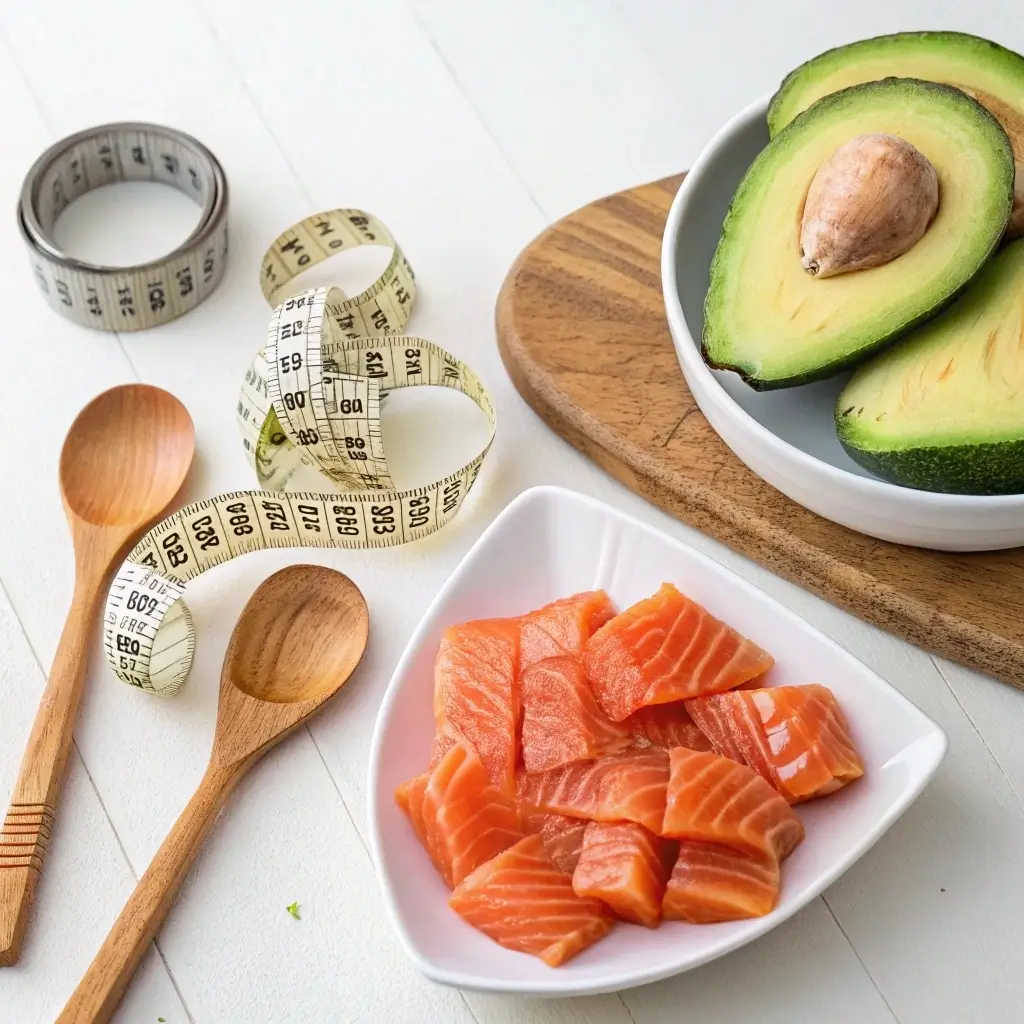
Curious how it compares? Learn more in our Pesto and Alfredo Sauce Pairings—a guide to balancing richness with nutrients.
Is Salmon Avocado Roll Healthy Because of Omega-3s in Salmon?
1. Sodium from Soy Sauce and Sushi Rice
Even though the salmon avocado roll is healthy, sushi in general can sneak in a lot of sodium—especially if you dip every bite in soy sauce. Just one tablespoon of regular soy sauce can contain 800–900mg of sodium, almost half your daily recommended limit.
Also, sushi rice is often seasoned with rice vinegar, sugar, and salt, so the roll itself isn’t sodium-free. If you’re watching your blood pressure or limiting salt, opt for:
- Low-sodium soy sauce
- Tamari (gluten-free and lighter in salt)
- Skipping extra dips altogether
2. Mercury in Raw Fish (Is Salmon Safe?)
While many sushi lovers worry about mercury, the good news is salmon is one of the lowest-mercury fish you can eat. It’s generally considered safe—even for pregnant women when consumed in moderation.
That said, it’s still wise to:
- Limit sushi to 2–3 times per week
- Choose wild-caught or sushi-grade salmon when possible
- Mix in vegetarian or cooked options to keep things balanced
3. White Rice = Quick Carbs
Sushi rice is often made from short-grain white rice, which is high in simple carbs and low in fiber. This can lead to:
- Blood sugar spikes
- Less satiety compared to whole grains
If you’re managing blood sugar or trying to reduce carbs, ask your sushi spot if they offer:
- Brown rice
- Cauliflower rice (some places offer low-carb options!)
- Or request less rice per roll
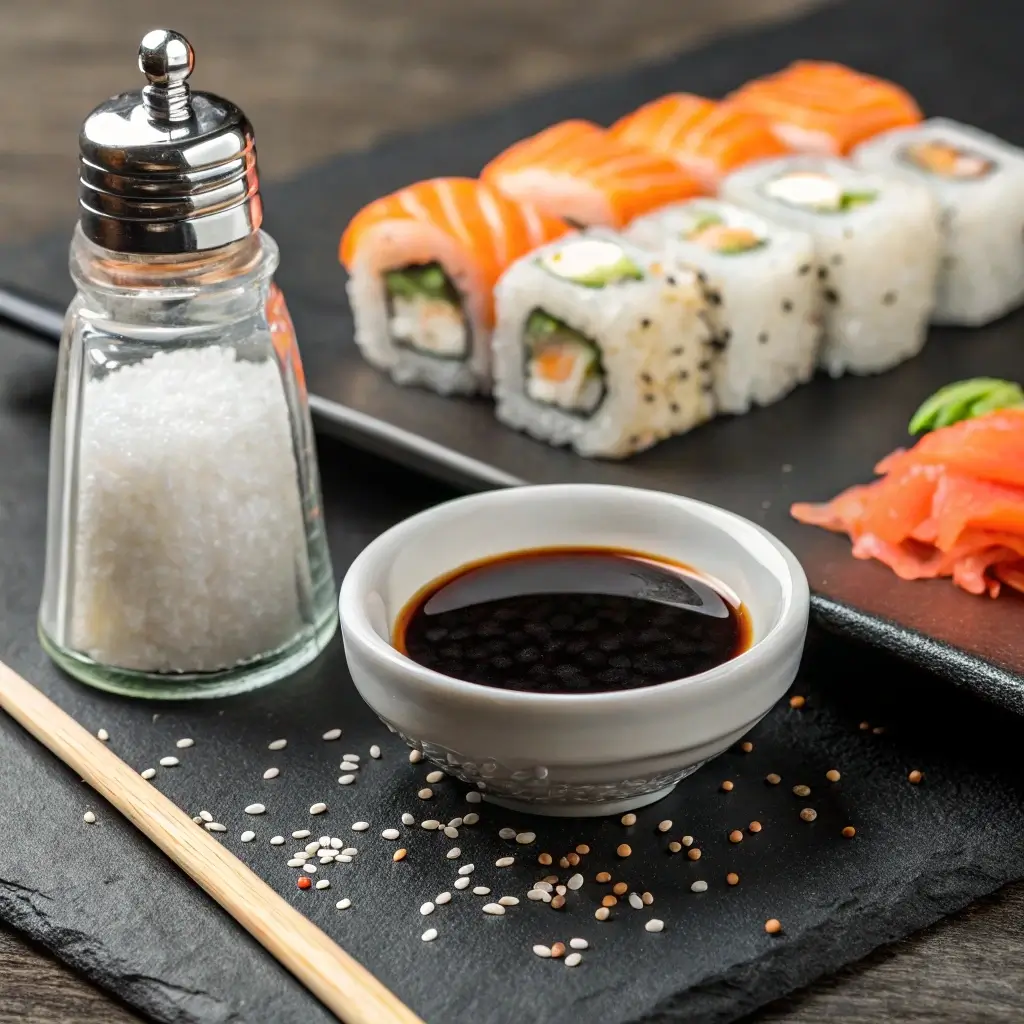
Learn more about balancing indulgence and nutrition with our Peanut Butter Coffee Cake—a smart treat that satisfies without the crash.
Smart Tips for a Healthier Sushi Order
Even though the salmon avocado roll is healthy, how you enjoy it can make a big difference. Here are some easy ways to make your sushi meal even smarter—without giving up the flavor you love.
1. Ask for Brown Rice or Light Rice
Brown rice adds fiber and B vitamins, and it digests more slowly—keeping you full longer. If your favorite sushi spot doesn’t offer brown rice, simply ask for:
- Less rice in each roll
- A hand roll (less rice than maki rolls)
- Or go for salmon sashimi with avocado slices for a low-carb option
2. Go Easy on Sauces and Dips
While soy sauce, spicy mayo, and eel sauce add flavor, they also add:
- Extra sugar
- Tons of sodium
- Unhealthy fats
Stick with low-sodium soy sauce, or better yet—use a light drizzle of ponzu or lemon juice. Want heat? Add wasabi instead of spicy mayo to keep it clean and simple.
3. Balance Your Meal
Instead of ordering three rolls and calling it a day, think of sushi like a main course, and build a balanced plate around it. Add:
- Miso soup – light and full of probiotics
- Seaweed salad – rich in minerals and fiber
- Edamame – adds extra protein and fiber
This approach gives you volume, variety, and better nutrition—without overloading on rice and sodium.
4. Watch Your Portions
A standard salmon avocado roll has about 300–350 calories. That’s great for a light meal. But if you’re eating 2–3 rolls plus sauce, your meal can quickly top 800–1000 calories.
Tip: Stick to 1 roll + a side, especially if you’re watching calories or trying to lose weight.
Looking for another smart, protein-packed bite? Try our Cottage Cheese Chocolate Pudding—a healthy dessert that feels like a treat.
❓ FAQs About Salmon Avocado Rolls
What is the healthiest sushi roll to get?
Some of the healthiest rolls include salmon avocado, cucumber roll, tuna sashimi, and veggie rolls with brown rice. These offer protein, fiber, and fewer calories than fried or tempura-style options.
How healthy is salmon avocado roll?
The salmon avocado roll is healthy thanks to its balance of protein, omega-3 fats, and fiber. It’s one of the best choices for a filling, nutritious sushi option—especially when you go light on sauces.
How healthy is salmon and avocado?
This combo delivers a double dose of heart-healthy fats and nutrients. Salmon provides omega-3s and protein, while avocado offers potassium and monounsaturated fats. Together, they support brain health, satiety, and energy.
Is salmon sushi healthy for weight loss?
Yes, salmon sushi—especially in sashimi or salmon avocado rolls—is great for weight loss. It’s low in calories, high in protein, and keeps you feeling full. Just watch the rice and sauce to keep the carbs and sodium in check.
✅ Conclusion
So, is salmon avocado roll healthy? In one word: yes—especially when compared to fried rolls or mayo-covered options. This roll delivers a clean mix of protein, healthy fats, and satisfying flavor.
As with any meal, the key is in the balance. Skip the heavy sauces, watch your portions, and pair your roll with fiber-rich sides. Whether you’re eating out or rolling at home, the salmon avocado roll is a smart, satisfying, and health-forward sushi pick.
👉 Want to try it yourself? Don’t miss our Salmon Avocado Roll Recipe to recreate it the healthy way!
👉 Follow us on Pinterest for easy sushi recipes, nutritious bowls, and smart meal ideas every day.
Is Salmon Avocado Roll Healthy? A Smart Sushi Choice Explained (2025)
This simple and nutritious sushi roll pairs rich salmon with creamy avocado for a satisfying, omega-3-packed meal. It’s one of the healthiest choices at the sushi bar—great for clean eating, low-carb meals, or post-workout refueling.
- Prep Time: 10 minutes
- Total Time: 10 minutes
- Yield: 1 roll (6–8 pieces) 1x
- Category: Main Course / Sushi
- Method: No-cook
- Cuisine: Japanese Fusion
Ingredients
1 sheet nori (seaweed)
½ cup sushi rice (prepared with rice vinegar)
2–3 slices sushi-grade raw salmon or smoked salmon
¼ avocado, thinly sliced
1 tsp sesame seeds (optional)
Soy sauce or tamari for dipping
Pickled ginger and wasabi for serving (optional)
Instructions
Lay the nori sheet shiny side down on a bamboo mat.
Spread an even layer of rice over the nori, leaving 1 inch at the top edge clear.
Arrange salmon and avocado slices horizontally near the bottom.
Carefully roll using the mat, pressing tightly as you go.
Slice into 6–8 pieces using a wet sharp knife.
Serve with soy sauce, ginger, and wasabi as desired.
Notes
Use brown rice for extra fiber.
For a lower-carb option, make it without rice (just wrap in nori).
Can be made with cooked or smoked salmon if you prefer.
For extra crunch, add cucumber or radish strips.
Nutrition
- Serving Size: 1 roll
- Calories: 310
- Sugar: 1g
- Sodium: 360mg
- Fat: 14g
- Saturated Fat: 3g
- Unsaturated Fat: 11g
- Carbohydrates: 28g
- Fiber: 3g
- Protein: 15g
- Cholesterol: 25mg

